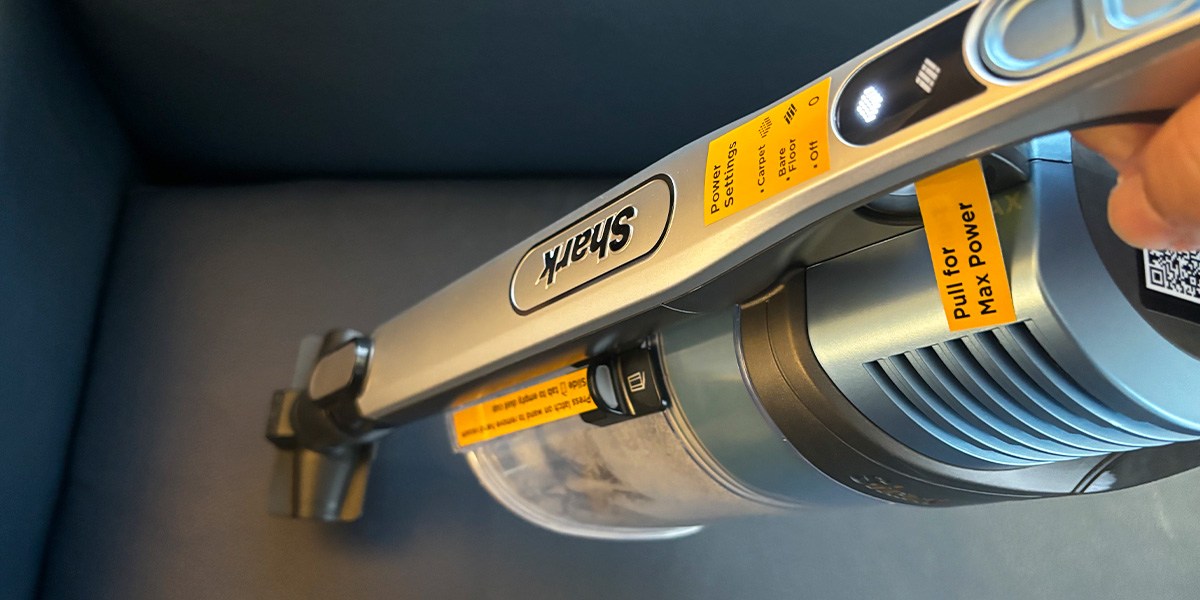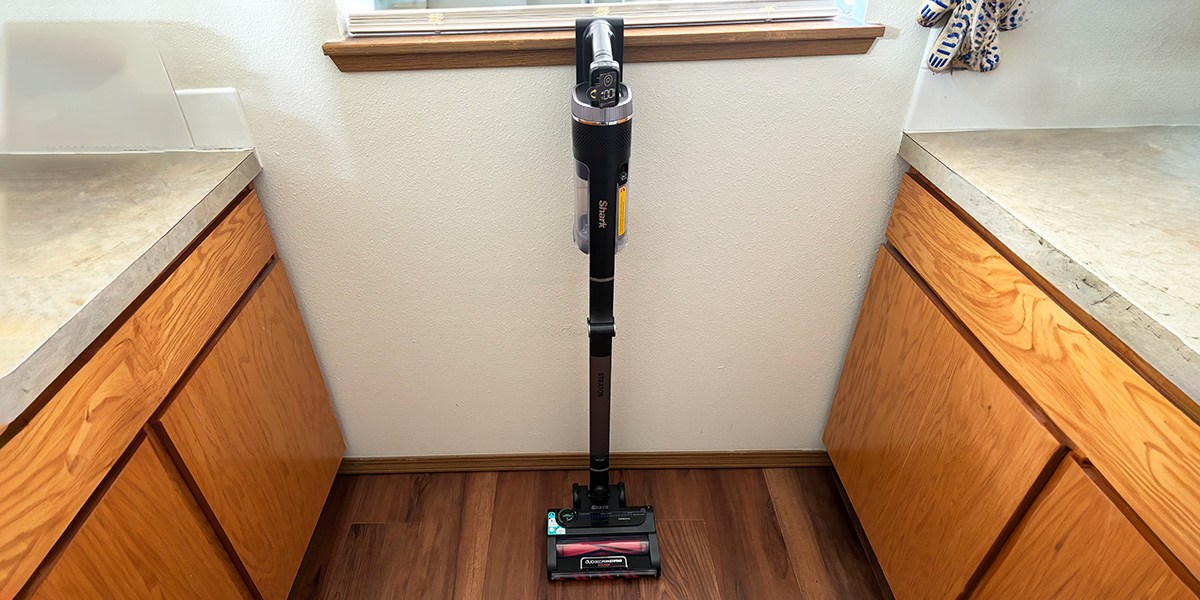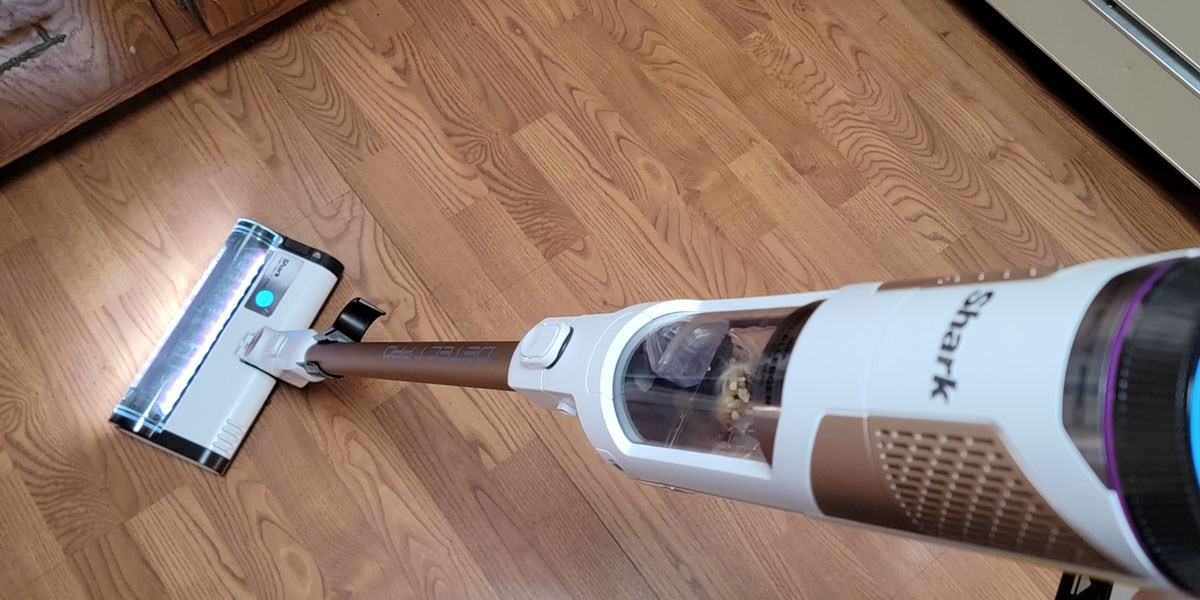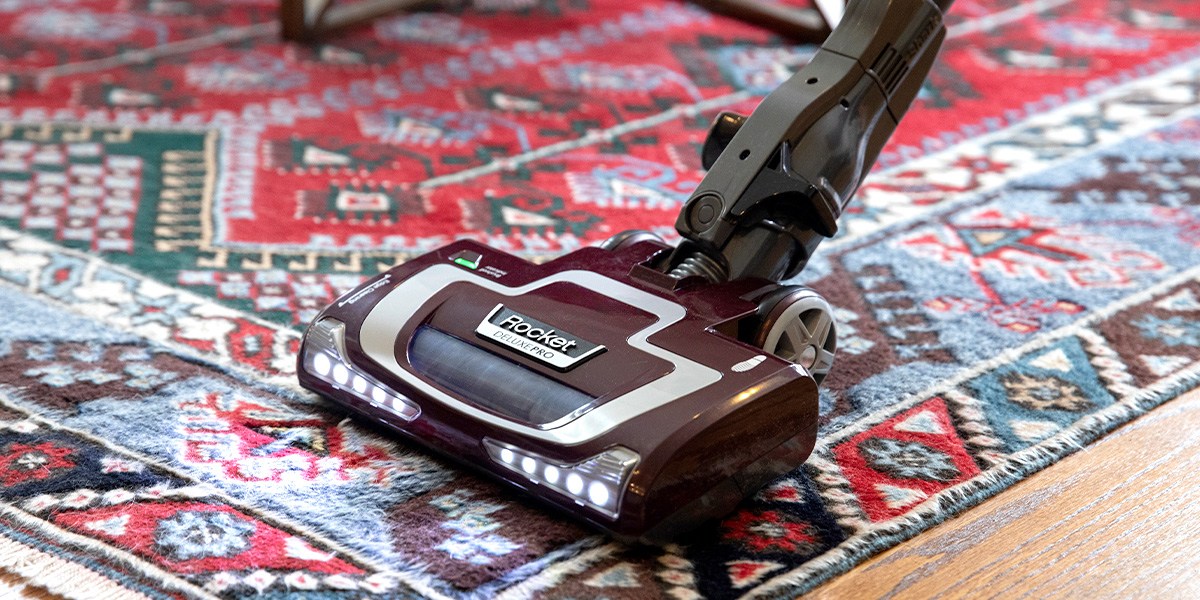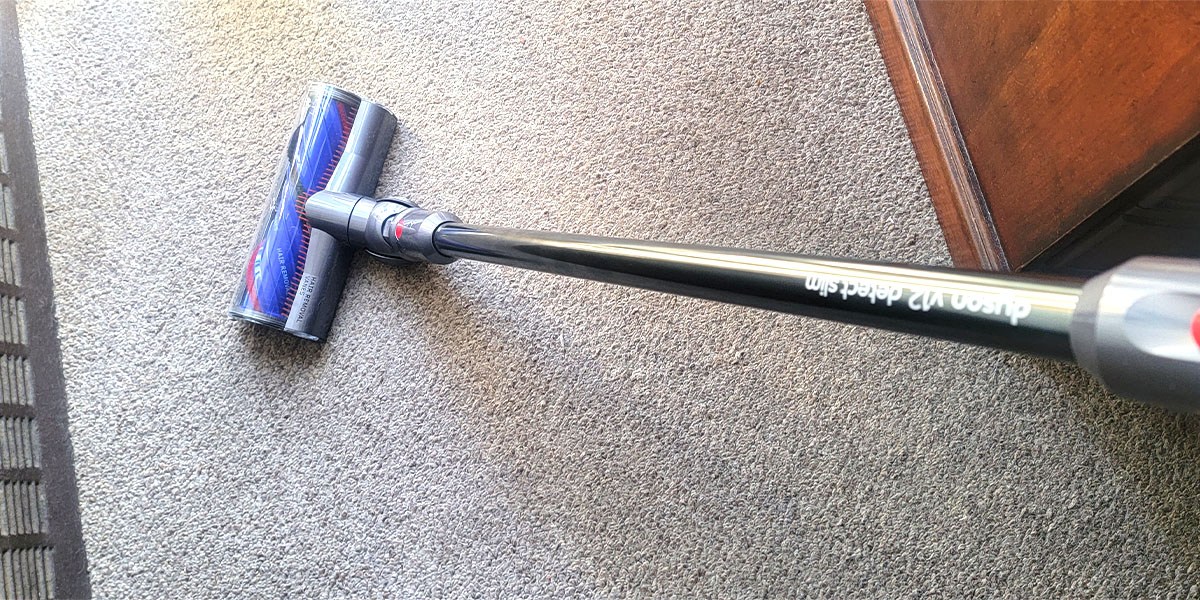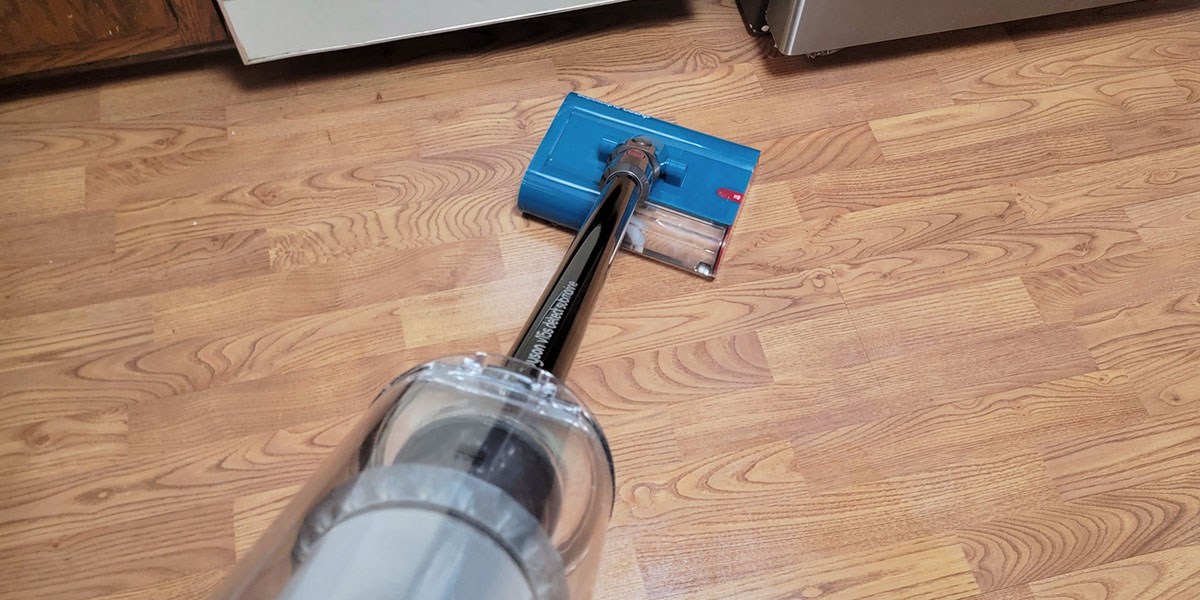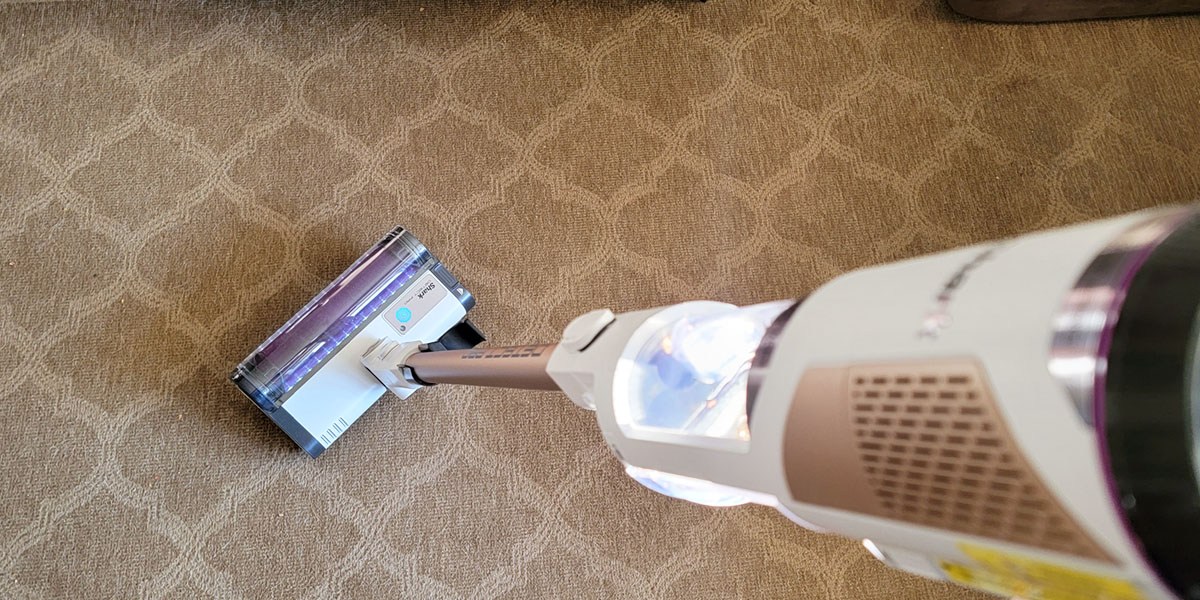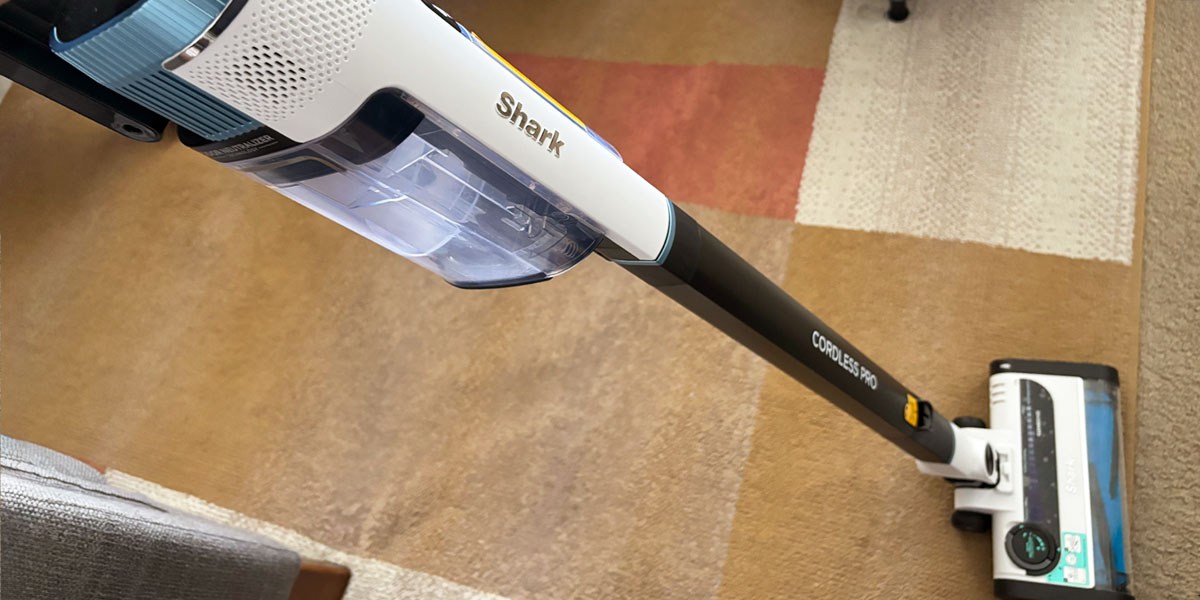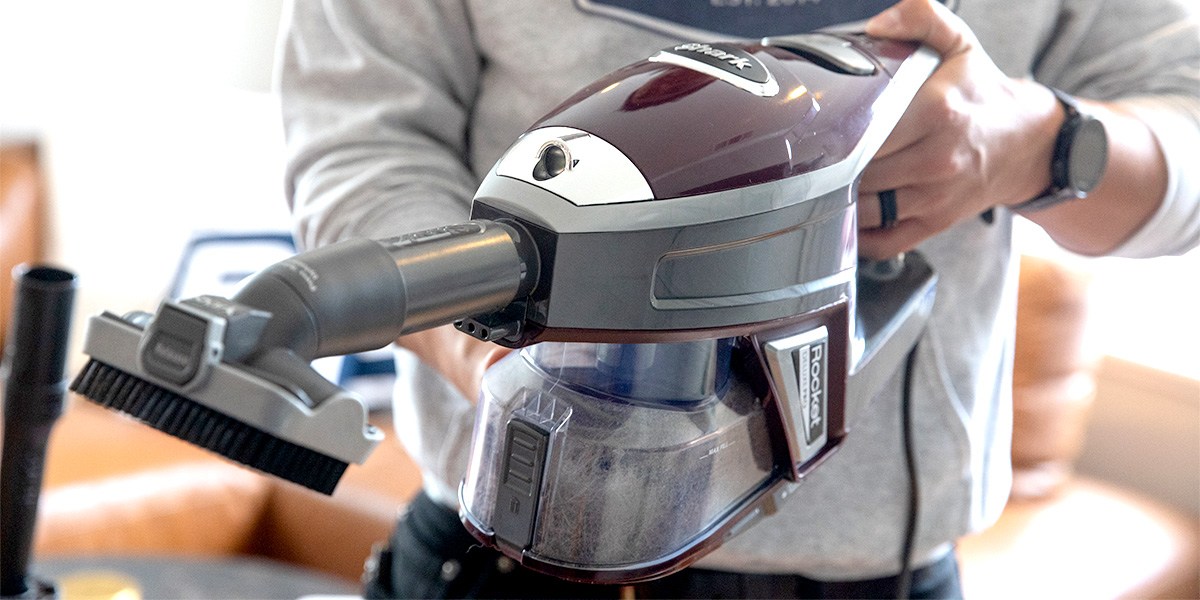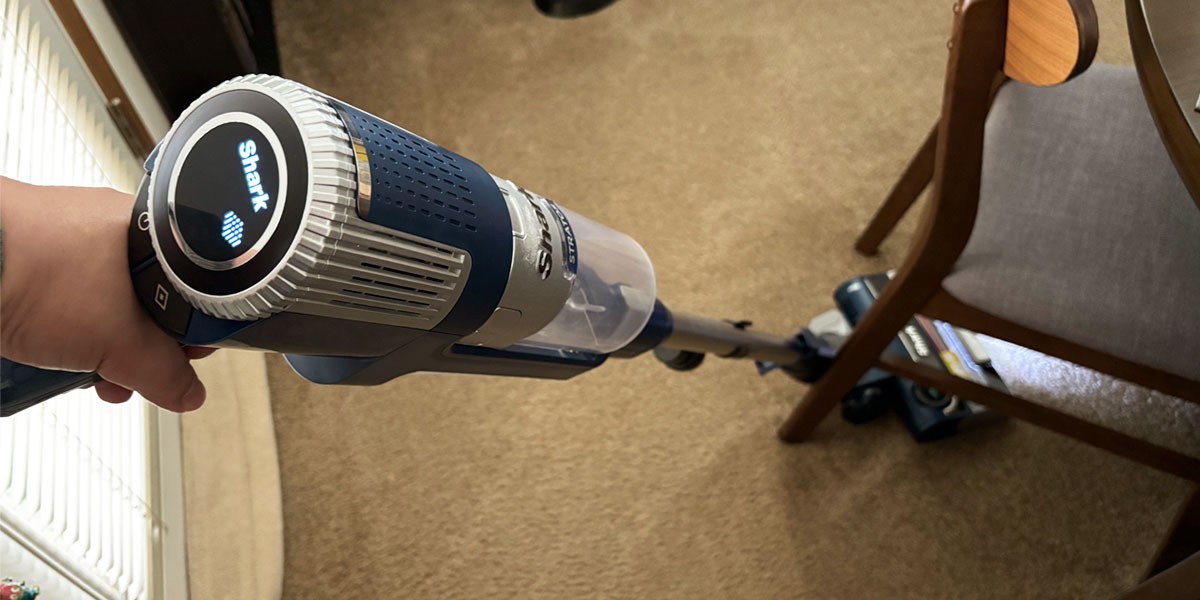We’ve tested four Shark stick vacuums and two Dysons
Shark and Dyson are two of the biggest names in the vacuum game, offering some of the top-selling models in all categories. But the two manufacturers’ stick vacuums often get the most buzz because they combine top-notch power with a comfortable, lightweight design.
Choosing between Shark and Dyson stick vacuums isn’t easy, though. The brands offer many similar features, including similar run times, dustbin capacity and even cleaning performance. But Dyson often equips its stick vacuums with cutting-edge technology, such as their Fluffy Optic cleaner heads that have an angled green light to reveal hidden dirt on hard floors.
Shark offers its own unique features, including the DuoClean brushroll, which provides a deeper cleaning of both carpeting and hard flooring. However, the biggest difference between Shark and Dyson stick vacuums may be their price: All of the Sharks we tested were priced under $450, while the Dysons cost much more.
Ultimately, we found that the Dyson V15 Detect is the best, provided it fits your budget. Its cleaning power makes it a viable alternative to a full-size upright but without all the weight and bulk. But if you can’t see spending over $700 for a cordless stick vacuum, we also love the Shark Cordless Detect Pro, which provides an excellent cleaning performance, plus a self-emptying base that keeps you from having to empty its dustbin for up to a month.
Shark vs. Dyson cordless vacuum specs
Shark and Dyson stick vacuums are similar in some areas, like battery life and dustbin size. However, their specs differ for key features like weight and maneuverability.
Shark stick vacuums
Shark stick vacuums are fairly heavy but offer solid battery life and suction power at a more affordable price point than Dyson models.
Shark Vertex Ultra Lightweight Cordless specs
The Shark Vertex Ultra Lightweight Cordless Vacuum aced our suction tests on both hard flooring and carpeting.
Product Specifications
Run Time: 58 minutes | Suction Power: 281 W | Bin Capacity: 0.34 qt | Weight: 9.04 lb
Weighing just over 9 pounds, the Shark Vertex Ultra Lightweight Cordless Vacuum is somewhat heavy for a stick vacuum. Still, we found it very easy to maneuver, thanks to its swivel head that can turn at right angles and effectively clean beneath furniture and in tight corners. It has a pretty small dustbin that holds less than half a quart, so it may need to be emptied more frequently in a large home. However, we were big fans of its hygienic emptying design that disposes of debris with the simple press of a sliding button that kept our hands clean.
The Vertex Ultra Lightweight Cordless has an advertised battery life of up to 60 minutes, and it lived up to those claims during testing, cleaning for 58 minutes before needing to recharge. We were also impressed with its suction power, which allowed it to pick up various types of debris like sugar, cereal and faux fur in one pass on both hard flooring and carpeting. Its self-cleaning brush roll never got tangled, either.
Shark Stratos Cordless specs
The Shark Stratos Cordless features a self-cleaning brushroll that never got tangled with hair during testing.
Product Specifications
Run Time: 60 minutes | Suction Power: 309 W | Bin Capacity: 0.72 qt | Weight: 8.9 lb
Like the Shark Vertex Ultra Lightweight Cordless Vacuum, the Shark Stratos Cordless can clean for up to 60 minutes on a single charge. During testing, this was enough time to clean over 420 square feet of carpeting and hard flooring, as well as other surfaces with its included upholstery brush, dusting attachment and crevice tool. Its suction power allowed it to pick up most types of debris in a single pass on hard floors and carpeting. Like the Vertex, it also has a self-cleaning brush roll, so we didn’t have to pull any hair or fibers from it after cleaning.
At 8.9 pounds, the Stratos Cordless is slightly lighter than the Vertex, so it easily moves around furniture and other obstacles. Its swivel head got into tight corners and under furniture during our testing, too. Its dustbin can hold over 0.7 quarts, which is double the capacity of the Vertex. That makes it an excellent option for larger homes because it requires less frequent emptying.
Shark Cordless Detect Pro specs
The Shark Cordless Detect Pro impressed the testing team with its super strong suction that rivals the power of corded models.
Product Specifications
Run Time: 60 minutes | Suction Power: 240 W | Bin Capacity: 0.42 L (internal)/2 L (on the base) | Weight: 6 lb
The Shark Cordless Detect Pro stands out among the Shark stick vacuums we tested for its usability and convenience. It’s the only model we tried that features a self-emptying base that can hold up to 30 days’ worth of debris. Its internal dustbin holds up to 0.42 liters, or 0.44 quarts, less than the Stratos Cordless but more than the Vertex Ultra Lightweight Cordless. Shark advertises a 60-minute run time for the Cordless Detect Pro, and it came close during our testing, cleaning for 52 minutes in Eco mode.
During testing, the Cordless Detect Pro’s suction power was impressive, so it’s a legitimate alternative to a traditional corded model. It removed at least 91% of various types of debris like ground coffee, kosher salt, birdseed and cereal in a single pass on both hard floors and carpeting. It also removed 100% of pet hair from the carpeting in our testing area in just one pass. At 6 pounds, it is also the lightest of the Shark stick vacuums we tested, making it easy to move around furniture and even carry up and down stairs.
Shark Rocket Pet Plus specs
The testing team appreciated the narrow cleaner head on the Shark Rocket Pet Plus, which helped it squeeze into small spaces.
Product Specifications
Cord length: 30’ | Suction Power: 500 W | Bin Capacity: 0.68 qt | Weight: 8.6 lb
The Shark Rocket Pet Plus is the only corded model we tested, but its 30-foot cord was long enough to navigate large rooms with large pieces of furniture, and sometimes stretched across multiple rooms without us needing to switch outlets during testing. It weighs under 9 pounds, so it was easy to maneuver around chairs and other obstacles. It also has a narrow cleaner head, which allowed it to fit in tight areas.
Its dustbin holds just under 0.7 quarts, so its capacity is greater than the Vertex Ultra Lightweight Cordless and Cordless Detect Pro. Its dust container was easy to empty, too, so we could quickly get back to cleaning after emptying it. Thanks to its solid suction power, picking up pet dirt, pet hair and other debris on hard surfaces and carpeting was a breeze. We were impressed with how well it collected pet hair and that the self-cleaning brush roll never got tangled.
Dyson stick vacuums
The Dyson stick vacuums we tested cost a pretty penny, but they offer excellent suction and innovative features that make them worth the price for some homes.
Dyson V12 Detect specs
The testing team had no trouble steering the Dyson V12 Detect Slim, thanks to its lightweight design.
Product Specifications
Run Time: 60 minutes | Suction Power: 150 AW | Bin Capacity: 0.08 gal | Weight: 5.22 lb
At just over 5 pounds, the Dyson V12 Detect Slim is the lightest of all the stick vacuums we tested. It was exceptionally easy to navigate around furniture and even carry up and down stairs. It also has an on/off button rather than a trigger like the Dyson V15 Detect, so it was much more comfortable to clean with during testing. Because of its more compact size, though, the V12 has the smallest dustbin of all the models we tested, which may mean more frequent emptying in a larger home. Fortunately, the bin is extremely easy to empty, with a point-and-shoot emptying mechanism that keeps your hands clean.
Dyson advertises a 60-minute battery life for the V12 Detect Slim, and it came close during testing, cleaning for 54 minutes in Eco mode before needing to recharge. For such a lightweight stick vacuum, we were also impressed with its suction power. It picked up various debris in a single pass, including ground coffee, kosher salt and dry pet food, on both hard surfaces and carpeting, only occasionally needing a second pass for larger, heavier debris. It also removed all visible pet hair from our testing area, which housed two medium-to-large dogs.
Dyson V15 specs
The testing team was impressed by the long battery life of the Dyson V15 Detect.
Product Specifications
Run Time: 60 minutes | Suction Power: 240 AW | Bin Capacity: 0.2 gal | Weight: 6.83 lb
Like the V12 Detect Slim, the Dyson V15 Detect has an advertised battery life of up to 60 minutes. It did even better during testing, cleaning for 69 minutes in Eco mode before needing to recharge. It also ran for 43 minutes in Auto mode, which automatically adjusts power based on the flooring type, so we had more than enough time to clean 1,000 square feet. It weighs over a pound more than the V12 but at least 2 pounds less than the Shark models we tested. It was easy to move around furniture and other obstacles and even carry up and down stairs.
The V15 Detect’s suction really sets it apart, though, rivaling the power of a corded upright vacuum. It picked up nearly all types of debris, including kosher salt, ground coffee and cereal on both hard floors and carpeting in one pass and cleaned along the edges of our testing area just as effectively, removing all debris in a single pass. Its dustbin capacity is also twice that of the V12 Detect Slim and on par with the largest Shark models, so it doesn’t require emptying too often.
Key differences
- Price: The Shark and Dyson models we tested differ significantly in price, with the most expensive Dyson costing $250 more than the priciest Shark model.
- Weight: Shark stick vacuums are heavier than the Dyson models we tested, weighing at least 2 pounds more.
- Special features: Both the Shark stick vacuums and Dyson models have special features that enhance the cleaning experience or make it more convenient. The Shark Cordless Detect Pro has a self-emptying base that can hold up to a month’s worth of debris, so you don’t have to empty the vacuum after each use. The Dyson V12 Detect Slim and V15 Detect both come with the Fluffy Optic cleaner head that emits a green light that reveals hidden dirt to ensure a deeper clean.
- Battery life countdown: The Dyson V12 Detect Slim and V15 Detect both offer a battery countdown that provides the number of minutes left based on the chosen cleaning mode. The Shark vacuums we tested with a battery life indicator aren’t as precise, so they don’t provide the number of minutes left before recharging is required.
Key similarities
- Cleaning performance: While they vary in suction power, all the Shark and Dyson stick vacuums we tested offered an impressive cleaning experience. Some models, like the Shark Cordless Detect Pro and the Dyson V15 Detect, are powerful enough to replace a traditional corded vacuum.
- Battery life: All the Shark and Dyson stick vacuums we tested can clean for up to 60 minutes, depending on the cleaning mode chosen.
- Auto power adjustment: Both the Shark and Dyson models we tried feature a cleaning head or mode that automatically adjusts its suction based on the flooring to ensure the deepest clean and longest cleaning time.
- HEPA filtration: The Shark and Dyson stick vacuums we tested feature high-efficiency particulate filtration systems that can trap up to 99.7% of dust, allergens and other particles.
Testing
To accurately evaluate the Dyson and Shark stick vacuums, we conducted specific tests to assess their suction power. We were particularly interested in how the vacuums handled debris in different sizes and consistencies.
Handling fine debris like sugar and ground coffee
We assessed how well the Dyson and Shark stick vacuums picked up fine debris using sugar and ground coffee.
When testing the Shark Vertex Ultra Lightweight Cordless Vacuum, we placed half a teaspoon of sugar on low-pile carpet and half a teaspoon of ground coffee on vinyl tile, noting how many passes it took to remove the debris.
With the Shark Stratos Cordless Vacuum, we set half a teaspoon of sugar on low-pile carpeting and half a teaspoon of sugar on vinyl plank flooring and recorded how many passes it needed to remove the mess.
For the Shark Cordless Detect Pro, we placed 5 grams of ground coffee on laminate flooring, 5 grams on low-pile carpet and 5 grams on medium-pile carpeting and recorded what percentage of the debris was removed in a single pass.
When testing the Dyson V12 Detect Slim, we placed 8 grams of ground coffee on laminate, 8 grams on tile, 5 grams on low-pile carpet and 5 grams on medium-pile carpet. We then noted how many passes it needed to remove the debris.
With the Dyson V15 Detect, we placed 6 grams of ground coffee on laminate, 4 grams on tile, 5 grams on low-pile carpet and 5 grams on medium-pile carpet and recorded how many passes it needed to remove the debris.
Handling medium debris like coarse kosher salt
To test the vacuums’ ability to pick up medium debris, we used coarse kosher salt.
For the Shark Cordless Detect Pro, we placed 5 grams of kosher salt on laminate, 5 grams on low-pile carpet and 5 grams on medium-pile carpet and noted how many passes it needed to remove the debris fully.
With the Dyson V12 Detect Slim, we set 6 grams of coarse kosher on laminate, 6 grams on tile, 6 grams on low-pile carpet and 6 grams on medium-pile carpet. We then recorded how many passes it required to pick up all the debris.
When testing the Dyson V15 Detect, we placed 3 grams of kosher salt on laminate, 2 grams on tile, 2 grams on low-pile carpet and 2 grams on medium-pile carpet and noted how many passes it needed to remove the debris.
Handling large debris like cereal and dry pet food
We tested the vacuums’ ability to remove large debris using cereal and dry pet food.
For the Shark Vertex Ultra Lightweight Cordless Vacuum, we placed 2 tablespoons of cereal on low-pile carpet and 2 tablespoons on vinyl tile, recording how many passes it took to remove the debris.
With the Shark Stratos Cordless Vacuum, we placed 1 tablespoon of cereal on low-pile carpeting and 1 tablespoon on vinyl plank flooring and noted how many passes it needed to pick up the debris.
When testing the Shark Cordless Detect Pro, we placed 5 grams of cereal on laminate, 5 grams on low-pile carpeting and 5 grams on medium-pile carpeting and recorded the percentage of debris it removed in a single pass.
For the Dyson V12 Detect Slim, we set 12 grams of dry pet food on laminate, 12 grams on tile, 10 grams on low-pile carpeting and 10 grams on medium-pile carpeting and noted how many passes were needed to remove the pieces.
With the Dyson V15 Detect, we placed 10 grams of cereal on laminate, 8 grams on tile, 9 grams on low-pile carpeting and 9 grams on medium-pile carpeting and recorded how many passes it needed to remove the debris.
Handling pet hair
To test the vacuums’ abilities to pick up pet hair, we used dog hair and faux fur when pet hair was unavailable.
For the Shark Cordless Detect Pro, Dyson V12 Detect and Dyson V15 Detect, we tested in an area that housed two medium-to-large dogs. For the Shark Rocket Pet Plus, we tested in an area with a short-haired dog. In both situations, we noted how many passes it took for the vacuums to remove all visible dog hair on laminate, hardwood, low-pile carpet and medium-pile carpeting.
With the Shark Vertex Ultra Lightweight Cordless Vacuum and Shark Stratos Cordless Vacuums, we set out lengths of faux fur on low-pile carpeting, vinyl plank flooring and vinyl tile and recorded how many passes they required to remove all the visible faux fur.
Setup comparison
The Dyson and Shark stick vacuums we tested were all easy to set up and had similar assembly processes, with just two to three steps.
After we removed the vacuums’ components from their branded boxes, we only had to connect each model’s wand to its main vacuum body and then attach the cleaning head to the bottom of each wand. We didn’t need to consult the manual for any of the Dyson or Shark models because the process was highly intuitive, and the components easily clicked into place without needing to be forced.
The setup process for each Dyson and Shark vacuum we tested took less than five minutes.
Suction comparison
Overall, we were impressed with the suction power of all the Dyson and Shark stick vacuums we tested, but the Dyson V15 Detect stood out for its superior suction that rivaled the power usually found in traditional upright vacuums.
The V15 Detect needed just a single pass to pick up nearly all types of debris on laminate, tile, low-pile carpeting and medium-pile carpeting. We mainly used it in Auto mode, which automatically increased suction based on the flooring surface to help prolong the battery life for truly efficient cleaning. We were especially impressed with how well the V15 removed pet hair from carpeting, picking up all visible hair, plus plenty we didn’t see based on how full its dustbin was after use.
The Shark Vertex Ultra Lightweight Cordless Vacuum and Stratos Cordless Vacuum also easily handled all types of messes, needing a single pass for most debris. They only occasionally needed a second pass because some particles were knocked out of their path.
The Shark Cordless Detect Pro was another highly successful model. It removed at least 98% of debris like kosher salt, ground coffee and cereal on laminate in a single pass, at least 92% on low-pile carpeting and at least 90% on medium-pile carpeting, though in every case, it looked like it had removed all visible debris.
While the Dyson V12 Detect Slim didn’t offer as much suction as the Dyson V15 Detect, it was still pretty powerful. It removed all debris from laminate, tile, low-pile carpeting and medium-pile carpeting in a single pass, except for dry pet food on tile (because a few pieces were blown out of its path) and coarse kosher salt on medium-pile carpeting. In both cases, though, a second pass removed the remaining debris, so we found it cleaned very efficiently, taking just five minutes to thoroughly clean 120 square feet.
Design comparison
All the Dyson and Shark models we tested feature a fairly similar design, with a main vacuum body that can convert to a hand vac, a detachable wand and a removable cleaning head.
However, the Dyson models are significantly lighter than most Shark models. The Dyson V12 Slim Detect, the lightest of all the models tested, weighs just 5.22 pounds, while the Dyson V15 Detect weighs 6.83 pounds. Only the Shark Cordless Detect Pro is lighter than the V15, weighing 6 pounds. All the other Shark models weigh just under or above 8 pounds, so they are a bit bulkier and more difficult to carry up and down stairs.
But all the Shark models we tested feature a one-touch on/off button, so we didn’t have to hold down a trigger the entire time we cleaned. The Dyson V12 Detect Slim has a similar design, but the V15 Detect has a power trigger that we had to hold while cleaning, which led to some hand fatigue when we cleaned for more than five minutes at a time.
The Shark stick vacuums all come with a single cleaning head that automatically adjusts based on the flooring. On the other hand, the Dyson models both come with two cleaning heads: a Digital Motor cleaner head for hard floors and carpeting and a Fluffy Optic cleaner head for hard floors. The Shark stick vacuums’ vacuum heads and the Dyson Digital Motor cleaner head feature self-cleaning brush rolls that move the hair away from the brush bar to prevent hair from getting tangled around it. After cleaning, we found no hair tangled around any of the Shark or Dyson models we tested.
Features comparison
All the Dyson and Shark models we tested can convert to a hand vac and come with accessories for floor-to-ceiling cleaning. They all come with a crevice tool for cleaning tight spaces and some type of tool designed specifically for pet hair.
However, the Dyson models offered the most unique special features that can make cleaning more effective and convenient. Both the V12 Detect Slim and V15 Detect have a full-color LCD display that provides the selected cleaning mode and a countdown of the remaining battery life in minutes, so we never ran out of power unexpectedly. They also have a piezo sensor that sizes and counts the particles the vacuums pick up, and the information is shown in a graph on the display to prove how thoroughly they’re cleaning.
The Shark models all have battery-life indicators, but they’re not precise, so they don’t provide the exact minutes of remaining cleaning time, which may lead to the battery dying unexpectedly.
Additionally, the Dyson vacuums have a Fluffy Optic cleaning head that emits a specially angled green light to illuminate hidden dirt and hair on hard floors. We were stunned by the amount of debris that the V12 Detect Slim and V15 Detect revealed on the laminate flooring in our testing area; with this feature, we were able to clean our hard surfaces more thoroughly.
The Shark models we tested offer LED lights that illuminate the area directly in front of their cleaner heads. However, these lights don’t highlight dirt invisible to the naked eye, so they didn’t clean quite as deeply on hard surfaces as their Dyson counterparts.
But the Shark Cordless Detect Pro does have one feature that the Dyson models lack: a self-emptying base. When you dock the vacuum after cleaning, it empties itself into the base, which holds up to 30 days’ worth of debris.
Price
The Shark Vertex Ultra Lightweight Cordless Vacuum usually retails for $429.99 and is available at Amazon.
The Shark Stratos Cordless Vacuum regularly costs $279.95 and can be found at Amazon.
The Shark Cordless Detect Pro typically retails for $449.99 and is available at Amazon and Best Buy.
The Shark Rocket Pet Plus usually costs $249.99 and can be found at Amazon.
The Dyson V12 Slim Detect regularly retails for $649.99 and is available at Amazon and Best Buy.
The Dyson V15 Detect typically costs $749.99 and can be found at Amazon.
How do they compare to other vacuums we tested?
- Weight: As we mentioned, most Shark models are heavier than the Dyson V12 Detect Slim and V15 Detect, but they’re also heavier than the Dyson Gen5detect Absolute, which weighs 7.72 pounds, and the same weight or heavier than the largest Dyson model we tested, the 8.6-pound Gen5outsize Absolute. Only the 9-pound Dyson V15s Detect Submarine, which houses a mopping mechanism in addition to its vacuuming components, matched the weight of some of the heavier Shark models. On the other hand, the Dyson V12 Detect Slim is the lightest stick vacuum we tested.
- Battery life: All the Dyson and Shark vacuums we tested for this comparison can clean for up to 60 minutes. The only stick vacuums we tested that run longer are the Dyson Gen5detect Absolute and Gen5outsize Absolute, which can both clean for up to 70 minutes.
- Price: All the vacuums we tested for this comparison cost under $800. The Dyson Gen5detect Absolute costs over $900, and the Gen5outsize Absolute retails for over $1,000.
Our expertise
Jennifer Blair has covered vacuums, carpet cleaners and other home-cleaning products for BestReviews for seven years. At home, she keeps her floors clean with a traditional upright vacuum, a robot vacuum and a cordless stick vacuum, but she has tested over a dozen vacuums for BestReviews, including Dyson, Shark and iRobot models.
Bottom line: Should you get a Dyson or Shark stick vacuum?
If money isn’t an issue, Dyson stick vacuums certainly get the edge, with powerful suction and cutting-edge features. In particular, the Dyson V15 Detect is our favorite because its cleaning performance is comparable to a traditional upright vacuum in a lightweight, easily maneuverable design. It also boasts special features that make cleaning more convenient, including a special light to reveal hidden dirt on hard floors. The V12 Detect Slim makes a perfect secondary vacuum because it weighs less than 5.5 pounds and is easy to carry up and down stairs.
However, a $600-plus stick vacuum definitely doesn’t fit all budgets. Shark stick vacuums offer more affordable options that still deliver excellent cleaning results. We especially like the Shark Cordless Detect Pro because it effectively cleans hard surfaces and carpeting and has a self-emptying base that cuts down on maintenance.
Prices listed reflect time and date of publication and are subject to change.
Check out our Daily Deals for the best products at the best prices and sign up here to receive the BestReviews weekly newsletter full of shopping inspo and sales.
Copyright 2024 BestReviews, a Nexstar company. All rights reserved.


